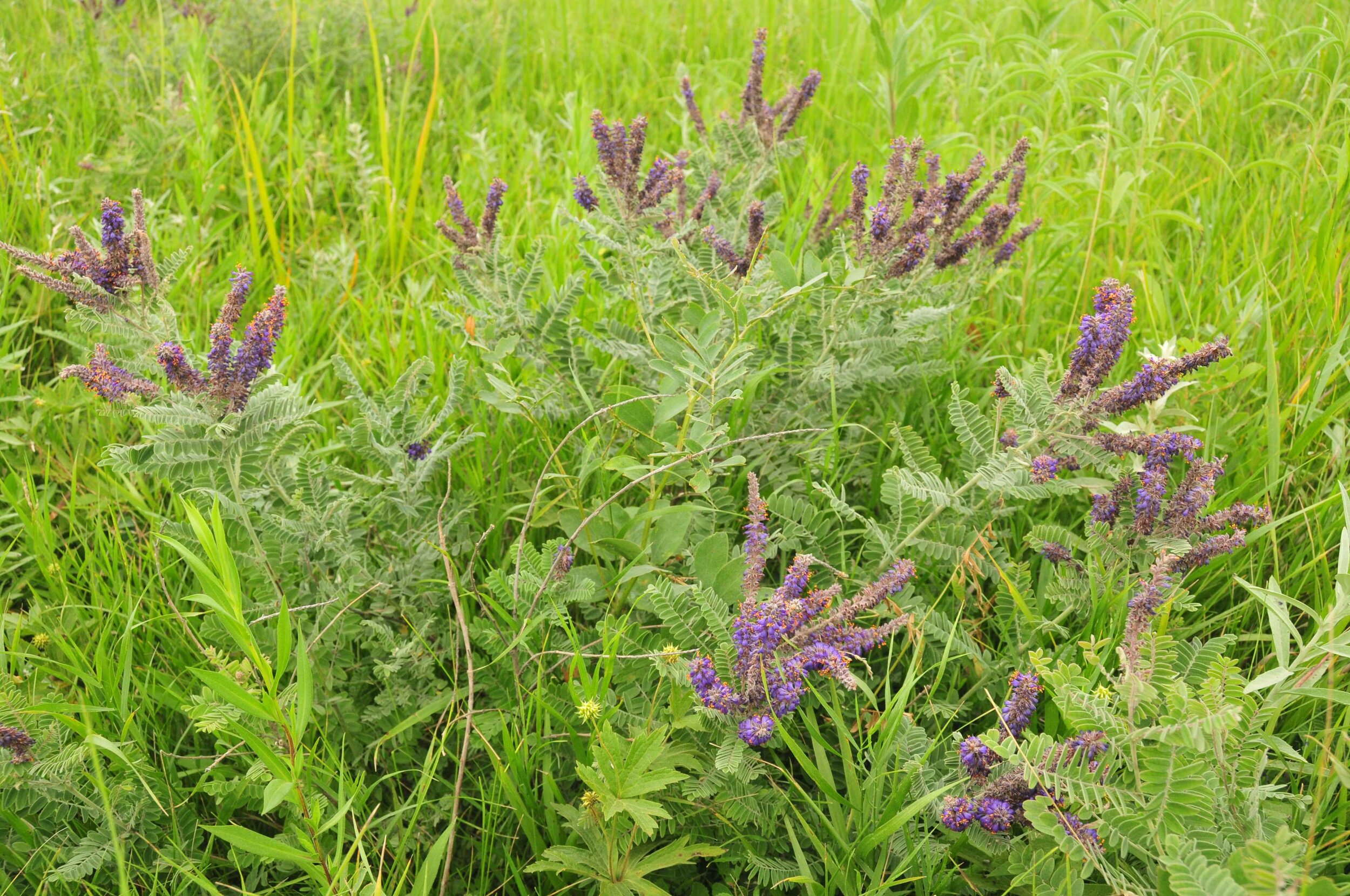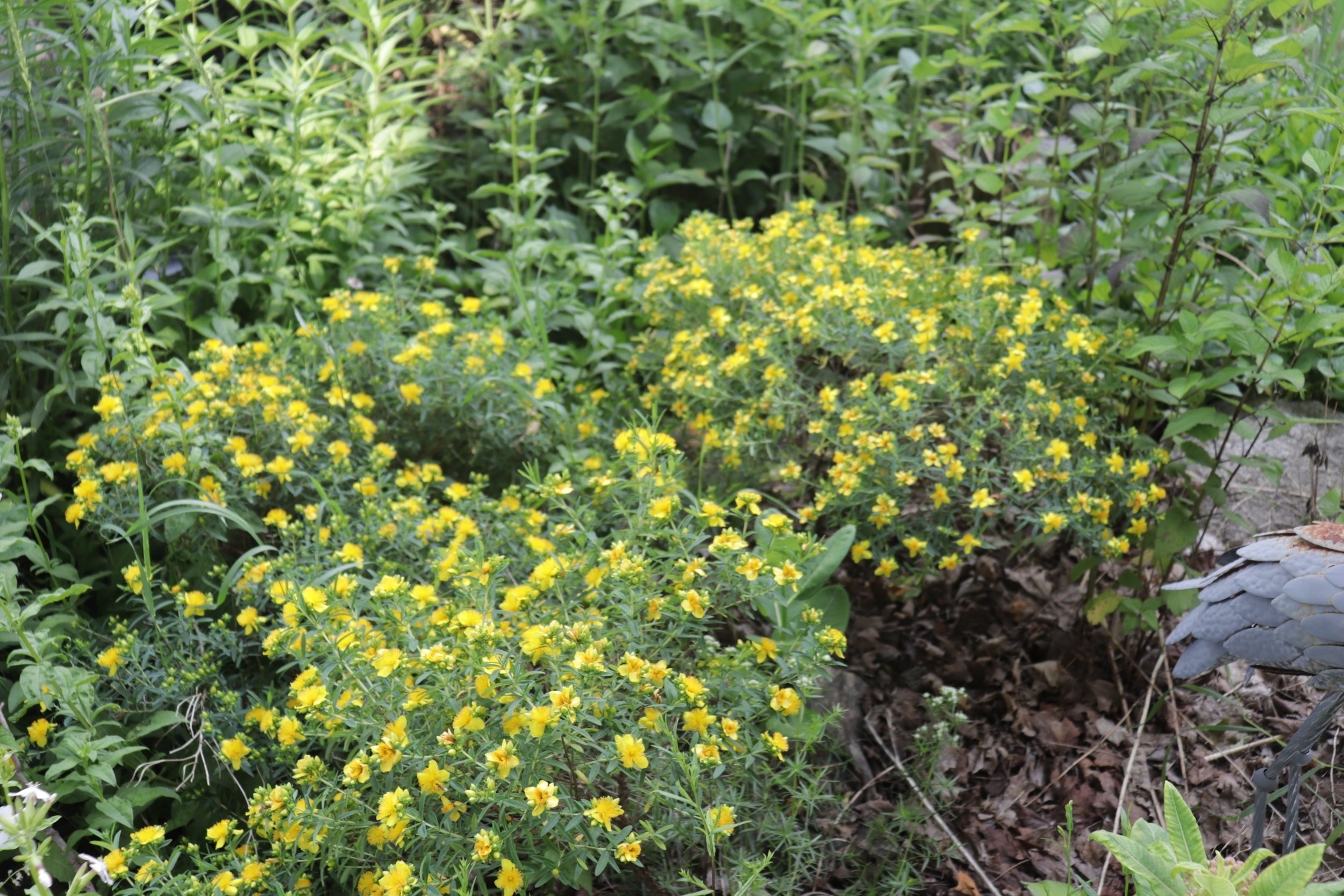Low-growing Native Shrubs for Ontario Gardens
Low growing shrubs can add versatility to your garden as you can grow them under windows where they won’t block your view, or under trees where they form excellent understory shrubs. Some are perfect for small, front yards where you don’t want to overwhelm the space with a 20ft tall serviceberry.
Thankfully, Ontario has some amazing low-growing native shrubs that stay under 1.8m, or 6ft, tall. Sure, you could choose Boxwood or Spirea but these exotic ornamentals are grown for looks alone and they don’t support the wildlife that we share our yards with.
In this article we will discuss our favorite low-growing, native to Ontario shrubs and how to use them in your garden.
Low-growing Native Shrubs
Lead Plant (Amorpha canescens)
Sun - light shade, 90cm/3ft, Sand/loam/clay, Dry-average
Leadplant is a small shrub naturally found in prairies, open woodlands and savannas. It’s not too picky about soil type but does like medium to dry conditions in full sun.
It’s deep taproot makes it very drought tolerant and hardy. In fact, early settlers had a hard time ploughing up the land where Leadplant grew. It is very drought and herbivore tolerant once established and bounces back quickly from rabbit browse once established. It is slow to establish and can be late to leaf-out in the spring so be patient with it!
Leadplant is valued in gardens for it’s lacy, gray-green foliage topped with showy purple flower spikes in early summer. Being a nitrogen fixer, it grows well in poor soils.
Bees, butterflies, moths and other pollinators are supported by the pollen and nectar found in the flowers.
Bearberry (Arctostaphylos uva-ursi)
Pt. shade-sun, <30cm/1ft, sandy/sand-loam/rocky/acidic, dry-average
Trailing evergreen shrub with thick, leathery leaves and is found in open woods, rocky/sandy shorelines and areas with exposed bedrock. It has the ability to tolerate hot, dry, sunny sites with medium salt exposure (including boulevards) but doesn’t tolerate foot traffic.
It needs acidic soil to thrive.
Wonderful, pink and red, bell-shaped flowers bloom in the spring and transform into edible red berries in the fall. Cobined with its evergreen leaves which turn reddish-purple in the fall, this shrub is a real winner.
Due to its low height it doesn’t require pruning and can be used more as a groundcover than a shrub.
Larval host for the Hoary Elfin, Brown Elfin, and Freija Fritillary. The flowers attract small native bees and provide a nectar source for hummingbirds.
Chokeberry (Aronia melanocarpa)
Sun to pt. shade, 1.8m/6ft, sand/loam/clay, moist - average
Chokeberry is a suckering shrub with a 6ft mature spread and mounding form. It is usually found in bogs, wetlands and thickets. Despite it’s affinity for wet areas it is adaptable to most gardens granted the soil doesn’t dry out.
In gardens, it is valued for it’s showy, white, spring blooming flowers. The flowers give way to dark purple/black berries. Fall colour is excellent and usually shades of red. The berries (pictured) are edible but very tart so they are best used for jams, jellies and juices.
Chokeberry produces suckers which can be cut back if they spread too much. It also benefits from rejuvenation pruning if you want to increase berry production. Prune in late winter.
The flowers support early pollinators at a time when flowers can be scarce. The berries are relished by birds. Chokeberry is a host plant for the Coral Hairstreak and is excellent for creating wildlife hedgerows.
New Jersey Tea (Ceanothus americanus)
Sun-light shade, 90cm/3ft, Sand/sandy-loam, dry-average moisture.
New Jersey Tea is a tough, compact shrub naturally found in prairies and open woods. In your garden it will adapt to sandy or loamy soils but it must be well-drained or else the roots will rot.
Tolerates compact soil, road salt and drought. The seed heads add garden interest well into winter. Its thick, deep taproot enables it to grow back quickly from rabbit browsing. The taproot makes it very hard to transplant successfully.
It maintains a bushy form so pruning is usually not necessary.
New Jersey Tea is a host plant for caterpillars of the Spring Azure, Summer Azure and Mottled Duskywing butterflies. The flowers are very popular with pollinators including native bees, butterflies and hummingbirds. Birds, including songbirds and Turkeys, will eat the seed heads over winter.
Sweet-fern (Comptonia peregrina)
Sun - pt. shade, <1.5m/5ft, sandy/sandy-loam/acidic, dry - moist soil.
Sweet fern is an aromatic, woody shrub with fern-like foliage and an attractive, mounding form. It is typically found in open woods, sandy barrens and recently disturbed habitat. It is adaptable to most well-drained soils including the most infertile of soils due to its ability to fix nitrogen. Does best in acidic, sandy soils. Salt tolerant.
A reliable spreader who will spread to form small colonies. Does not require pruning but you may have to thin out suckers to limit spread. Doesn’t transplant well.
Great for erosion control. Works well in medians and other hot dry areas.
The bur-like nutletts are provide attractive winter interest and make a pleasant flavoring for foods.
Hosts the caterpillars of 49 butterfly and moth species throughout its range, including the sweetfern underwing moth. Cedar waxwings eat the fruits and eastern cottontails use this shrub as cover. Deer resistant.
Shrubby Cinquefoil (Dasiphora fruticosa)
Sun-pt. shade, < 120cm/4ft, loam/sandy-loam/clay-loam, moist, well-drained soils.
Shrubby Cinquefoil is a low, compact shrub with a rounded form. It is generally found along sandy or rocky shorelines and wet prairies. In the garden it is easy to grow in most soil types but prefers moist, sandy-loams in full sun.
It is fairly drought tolerant once established. Tolerates early spring pruning to keep a more compact form.
Attractive gray-green leaves and long blooming yellow flowers (bloom for 2-3months) make this a really showy plant for native gardens.
The nectar and pollen found in the flowers support the needs of various bees, solitary wasps and flies including hover flies. The long bloom time of the flowers makes this a great shrub for extending bloom time in your garden.
The caterpillars of the Dorcas Copper butterfly feed on the foliage while the caterpillars of the Large Lace Border moth eat the flowers.
Bush Honeysuckle (Diervilla lonicera)
Sun, Part sun, Shade, 90cm/3ft, Sand/Loam/rocky, Dry - average
Bush Honeysuckle is an adaptable, low growing shrub often found growing along forest edges, fields and open woods. I have even found it growing out of cracks in bedrock so you know it’s tough! In your garden, it’s easily one of the most adaptable and versatile plants you can grow.
The suckering nature of this shrub makes it useful for massing and covering large areas. It maintains a uniform height so pruning is generally not necessary to maintain its form. If you don’t want it to spread then simply chop off the suckers. It does very well when massed under trees or used as a foundation plant under windows.
The yellow, trumpet-like flowers bloom from late spring well into summer. The fall foliage is incredible red/maroon colour.
The flowers provide an excellent source of nectar for bumblebees and hummingbirds. Bush Honeysuckle is the larval host for the Fawn Sphinx moth (Sphinx kalmiae). Its beauty and adaptability means it will quickly become a favorite in your garden.
St. Johns Wort (Hypericum kalmianum)
Sun - part sun, 90cm/3ft, sand/loam/rocky, moist-average
St. Johns Wort is a compact flowering shrub reaching about 3ft high with a 3ft spread. It’s native to the Great Lakes region where it’s generally found in dry open woods to moist lakeshore areas. In your garden it will thrive in most well-drained soils with full sun to part shade.
Showy and abundant yellow blooms come out in mid-summer and look especially great when the shrubs are massed. It maintains a bushy form and will not require pruning to keep an attractive form. St. Johns Wort is a good low-maintenance alternative to the over-used Boxwood hedge which provides very little benefit to wildlife.
Expect great fall colour with individual plants often having green, yellow and reds at the same time.
The showy flowers are frequented by native bees especially bumblebees and Metallic Green Sweat bees.
Creeping Juniper (Juniperus horizontalis)
Sun, <60cm/2ft, sand/loam/rocky, average-dry, well-draining soils.
Creeping juniper is a low, sprawling evergreen shrub who makes its home in dry, open woods, sand dunes and rock outcrops. It will tolerate a wide range of soils in your garden granted they are well-drained.
It will take hot, dry, sandy sites and shallow soil like a champ, gracing your garden with an evergreen presence despite adversity.
Foliage is typically blue-green but takes on hues of purple over the winter. Attractive dark blue berries (they’re technically cones) are to be found on mature specimens.
Note that cultivars of this shrub usually don’t produce the berries.
Expect this plant to spread non-aggressively to form a dense carpet of foliage. deer resistant and tolerates shallow soil. Does not tolerate foot traffic.
Wildlife value is considered to be high with birds seeking out its blue-green berries while small critters seek out shelter in the evergreen foliage.
Sand Cherry (Prunus pumila)
Sun-pt.sun, <1.8m/6ft, sand/loam, dry to moist
Grows naturally along sand dunes and rocky shores, making it a perfect choice for dry, sandy spots in your garden granted they get enough sun. In infertile soils, it will grow on the lower end of its height range.
A beautiful choice for sandy sites with its thick, waxy leaves and abundant white flowers in the spring. The flowers mature into purple fruits which are edible for humans but very tart.
The flowers are a hive of activity in the spring time, drawing in all kinds of early season pollinators. The fruits are readily eaten by birds, so good luck getting to them first!
Fragrant Sumac (Rhus aromatica)
Sun to pt. sun,1.8m/6ft, sand/loam/clay, dry to average soils
Fragrant Sumac is a sprawling shrub that is commonly found in dry open woods, glades and prairies. It tolerates a wide range of soils granted they are well-drained. It spreads by suckers and can spread as far as 8ft, making it an excellent groundcover shrub that doesn’t require pruning.
Yellowish catkin-like flowers bloom in summer and turn into red berries that persist into the winter months. Only female plants produce flowers and berries. Fragrant Sumac is excellent for massed plantings or drifts. It’s ability to tolerate drought and juglone makes it very versatile. Expect stunning fall foliage (see picture) as the leaves turn a vibrant red colour.
The flowers support native bees and the berries provide food for small birds and mammals. Deer resistant.
Smooth Rose (Rosa blanda)
Sun to pt. shade, 1.5m/5ft, sand/loam/clay, dry-average well-draining soils
Smooth Rose is a mostly thorn-less rose with a dense, mounding form and a suckering habit. Its usually found in open woods, prairies and other open dry areas. It adapts to most well-drained garden soils.
It’s valued in gardens for it’s showy, fragrant pink flowers and lack of thorns on new growth. The flowers turn into red rose-hips in late summer. An excellent alternative to the ecologically dysfunctional exotic roses that are used by traditional horticulture.
The flowers support many pollinators especially bumblebees. The rosehips are eaten by wildlife. Host plant for the larval stage of the Apple Sphinx Moth. Deer resistant.
Purple Flowering Raspberry (Rubus odoratus)
Full sun to dappled shade, <1.8m/6ft, Sand/loam/clay, average, dry but well-drained soils.
Purple Flowering Raspberry is a very showy plant with bold, maple-like leaves and large pink-purple blooms. It is commonly found as an under-story shrub in forests and forest edges. In your garden, it will do best in part sun conditions with average moisture. It will tolerate full sun(with sufficient moisture) and full shade (with reduced flowering).
The large, pink flowers bloom through-out summer, making this an excellent alternative to non-native rose bushes. The ripe fruit is edible with a strong raspberry flavor when ripe (many sources describe the fruit as insipid but I disagree). During winter months, the peeling bark has an interesting texture to add to gardens.
Tolerates pruning. You can expect it to sucker which is good if you are trying to fill in a large area, otherwise the suckers are easily removed (and given to friends!) to control spread.
During peak bloom time the bushes will be buzzing with bumblebees. Like other raspberries, this has hollow stems that provide habitat for cavity-nesting bees.
Meadowsweet (Spiraea alba)
Sun - pt. shade, 1.5m/5ft, sand/loam/clay. Prefers soil with abundant organic matter, wet to average soils.
Meadowsweet is an upright, clumping shrub commonly found in wetlands, bogs, shorelines and ditches. It adapts to most garden soils granted they don’t dry out.
A good plant for areas that are soggy in the spring but dry out later in the year. Tolerates shallow standing water.
This shrub is valued in gardens for its cone-shaped white flower clusters that bloom in summer. Meadowsweet can be a good alternative to the non-native and ecologically dysfunctional Japanese Spireas used in traditional horticulture.
The brown seed heads provide winter garden interest.
The flowers support a diversity of pollinators and other beneficial insects with it’s nectar and pollen. Host plant for caterpillars of the Spring Azure butterfly.
The seeds are eaten by small songbirds.
Snowberry (Symphoricarpos albus var. albus)
Sun, pt. shade, 1.5m/5ft, Sand/loam/rocky/infertile soil, average soils
Snowberry is an adaptable, bushy shrub found in woodland edges, glades and open slopes. It is easily grown in average moisture with full sun to part shade and thrives in poor soil.
Snowberry makes an excellent hedge and can even be trimmed lower than 5ft or into a formal look similar to boxwood. It is also great for naturalizing. It is a suckering shrub that can reach 4-6ft wide so keep this in mind when planning a hedge. Small pinkish-white flowers bloom during summer although they are not very noticeable. The flowers turn into plump, white berries that persist into winter to add garden interest.
Despite being inconspicuous, the flowers are attractive to hummingbirds and various native bees. Snowberry is a host plant for the Snowberry Clearwing moth. The hollow stems provide nesting sites for small cavity-nesting bees.
Not to be confused with the non-native Symphoricarpos albus var. laevigatus which is often found in nurseries.


















